| |
|
 | |
| MaltaWildPlants.com by Stephen Mifsud |

|
| |
|
|
 |  |  |  |
| External Links: |
|
Sinapis alba (White Mustard) |

Sinapis alba (BRASSICACEAE.)
Images for this profile are taken from the Maltese Islands after year 2000. |
|
| Nomenclature |
Species name : | Sinapis alba L. | Authority : | Carl von Linne, Sweden, (1707 - 1778) | Synonyms :
(basionym or principal syn.) |
|
Plant Family : | Brassicaceae Juss. (= Cruciferae )
(Mustard or Cress Family) | English name(s) : | White Mustard, White Charlock, Yellow Mustard | Maltese name(s) : | Mustarda, Mustarda Bajda | Status for Malta : | Indigenous. Present on the Maltese islands before man | Name Derivation : |
Sinapis: Latin name for mustard, as where the first plants of this genus. (Latin origin ); 2 = Mustard (Latin).
alba: Having a white colour. (Latin origin ); 2 = White, probably referring to the white appearance of the fruit pods due to their long white hair. (Latin).
| Remarks : | |
|
| Morphology and structure |
PLANT STRUCTURE: |
Character | Growth Form | Branching | Surface |
Description | | | |
General
Picture |  | 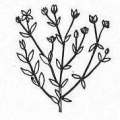 | 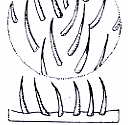 |
|
LEAVES: |
Character | Arrangement | Attachment | Venation |
Description | | | |
General
Picture |  | 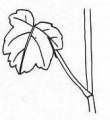 |  |
| |
Character | Leaf Shape | Leaf Margin | Remarks |
Description | | | Leaf bristles Leaves contain short, white bristles especially on their veins. |
General
Picture |  | 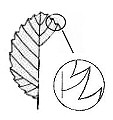 |  |
|
FLOWERS: |
Character | Colour | Basic Flower Type | No. of Petals | No. of Sepals |
Description | Pale Yellow Sometimes described as Sulphur yellow. | | 4 | 4 Thin, rod-shaped sepals, spread out perpendicularly to flower stalk. |
General
Picture | | 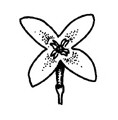 |  |  |
| |
Character | Inflorescence | Description | Ovary | Stamens |
Description | | The plant forms cluster of numerous pale yellow flowers (about 13mm across) at the apex of the branching stems. Every flower consists of 4 oval, non-overlapping yellow petals arranged diagonally to each other, 6 stamens and a central pistil with swollen stigma. When young the flowers are cup shaped, but with time the petals spread out like a shape of a cross. | | |
General
Picture |  |  | 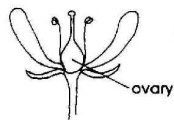 | 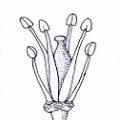 |
| |
Character | Scent | Average Flower Size | Pollen Colour | Other Notes |
Description | Mild Possess a faint sweet smell, which to some extent resembles Anisette. | 13mm | Yellow | - |
|
SEEDS: |
Character | No. Per Fruit | Shape | Size | Colour |
Description | 3-5 | Globular Spherical shape, like a small bead. | 2-3mm | Dark Reddish Brown |
General
Picture |  |  |  |  |
|
FRUIT AND OTHER BOTANICAL DATA: |
Character | Fruit Type | Colour of Fruit | Subterranean Parts | Other Notes |
Description | | Green Turns straw-colour or brown when seed pod is ripe and dries out. | | - |
General
Picture |  |  |  |  |
|
|
| Plant description and characters | |
Life Cycle: | Annual. |
Growth Form: | THEROPHYTE (annual plants, herbaceous) |
Habitat: | Uncultivated fields and wasteland especially on calcareous soils. |
Frequency: | Common |
Localities in Malta: | Not very common. Found as a crop escape near certain fields that cultivated this plant in the previous years as under the 'English Bridge' at Mtarfa, Qormi and Zebbug. |
Plant Height: | 70-140cm. |
| Dec-Apr |
Protection in Malta: | Not legally protected till the last update of this website (2/Mar/2022) |
Red List 1989: | Not listed in the Red Data Book of the Maltese Islands |
Poison: | |
A fleshy anual plant growing mostly in fields and calcium rich soils. At a glance, the plant looks alike the yellow-flowered Cruciferae found in Malta (eg: Brassica rapa subsp silvestris), but it has a specific characteristic which distinguishes it from them. this is the fruit pod which looks glowing white in light due to the presence of white bristles, at least half the length of the fruit. Hence the name of the plant (white mustard) may have originated from this fact.
The stem is longitudinally ribbed and has short white bristles all its length. The bristles are not hard or spiny.
The leaves are quite complex and different from the other Sinapis species; they are all stalked and have one or two pairs of leaf lobes at the base of the compound leaf followed by a much larger, terminal, deeply lobed leaf. The development of the structure of this compound leaf can be explained as follows. First there is a single stalked young leaf which starts to form lateral indentations at its lower part. These indents grow deep up to the midrib until eventually they form separate leaf lobes independent from the parent leaf. As a result these lobes become an opposite pair of small independent leaflets at the base. Usually two pairs of leaflets are formed this way along the leaf axis (rachis). Adult leaves can grow up to 20cm long. The general outline of the leaflets and main leaf is coarse serrated (saw like) and the leaf has prominent veins that may contain few short bristles.
The flower does not differ very much from the other yellow Cruciferae species in Malta. It is somehow more pale in colour (Sulphur colour), and the sepals are rod like and spread perpendicular to the flower stalk. The inflorescence is a raceme with 5-10 flowers open at a time. The young flowers are more compact and bowl-shaped with slightly overlapping petals, while the adult flowers get flatter and are at right angles to each other hence forming a shape of a cross.
The fruit, 3-5 seeded siliqua, are the most distinctive part of the plant. These are not very long, and possess a curved (sabre-shaped) beak, about 50% the length of the whole siliqua. The lower part of the fruit is bulging with the seeds inside. The outer walls of the fruit body have numerous fine, white bristles, which appear to glow white in sunshine. Seeds are globular in shape, about 2-3mm across and are dark reddish-brown in colour. There is usually 3 or 5 seeds per seed pod arranged in one or two pairs in the body of the fruit and one in the beak. Longer pods would have more pairs of seeds in their body, but there is always only one seed in the beak.
|
|
| Information, uses and other details |
Edible Uses
Leaves - raw or cooked [2, 5, 14, 52]. A hot pungent flavour, especially if eaten raw [KF]. Young leaves are used as a flavouring in mixed salads, whilst older leaves are used as a potherb [183].
Seed - sprouted and eaten raw [1, 34, 37, 52]. The seed takes about 4 days to be ready [244]. A hot flavour, it is often used in salads. A nutritional analysis is available [218].
The seed can be ground into a powder and used as a food flavouring [17, 34, 89, 171], it is the 'white mustard' of commerce [100, 105]. This is milder than the black mustard obtained from Brassica nigra [183]. The pungency of mustard develops when cold water is added to the ground-up seed - an enzyme (myrosin) acts on a glycoside (sinigrin) to produce a sulphur compound. The reaction takes 10 - 15 minutes. Mixing with hot water or vinegar, or adding salt, inhibits the enzyme and produces a mild bitter mustard [238].
Chemical composition of seeds [218]
Seed (Dry weight) In grams per 100g weight of food:
Water: 0
Calories: 500
Protein: 27.2
Fat: 35
Carbohydrate: 34
Fibre: 6
Ash: 4.5
In milligrams per 100g weight of food:
Calcium: 500
Phosphorus: 800
Iron: 16
Sodium: 5
Potassium: 732
VitaminA: 400
Thiamine: 0.5
Riboflavin: 0.37
Niacin: 8
VitaminC: 0
Notes: These are median figures of a range given in the report. [218]
Important drugs found in seeds
A bland, fixed oil, average of 25 per cent; the glucoside sinalbin, the most important constituent, and myrosin, an enzyme which converts sinalbin into an acrid (p-hydroxybenzyl isothiocyanate
), and other bodies. Volatile oil of mustard is not obtained from white mustard [WWW-09]
Medicinal Uses
The seed is:
| Antibacterial |
Destroys or prevents the growth of bacteria [WWW-32] |
| Anti-fungal |
Destroys or prevents the growth of fungi [WWW-32] |
| Appetizer |
Stimulate or increase the appetite [WWW-32] |
| Carminative |
Aids in expelling gas from the intestinal tract [WWW-32] |
| Diaphoretic |
Used to produce perspiration [WWW-32] |
| Digestive |
Aids digestions, hence breaking down of food and uptake of nutrients [271] |
| Diuretic |
Promotes the flow of urine and also lowers blood pressure [WWW-32] |
| Emetic |
Induces vomiting and hence emptying of the stomach [WWW-32] |
| Expectorant |
Used to induce the ejection of mucus, phlegm, and other fluids from the lungs and air passages by coughing or spitting. [WWW-32] |
| Rubefacient |
Reddens skin by increasing blood supply to it. [WWW-32] |
| Stimulant |
Increases the normal activity of body organs [271] |
The seed has a cathartic ( cleansing and purging of the intestines and bowels [271] ) action due to hydrolytic liberation of hydrogen sulphide [218]. In China it is used in the treatment of coughs with profuse phlegm and tuberculosis, pleurisy [176]. The seed is seldom used internally as a medicine in the west [238]. Externally it is usually made into mustard plasters (using the ground seed), poultices or added to the bath water. It is used in the treatment of respiratory infections, arthritic joints, chilblains and skin eruptions, etc. [238]. At a ratio of 1:3, the seed has an inhibitory action on the growth of fungus [176]. Care should be exercised in using this remedy because the seed contains substances that are extremely irritant to the skin and mucous membranes [238].
The leaves are carminative [218] ( inducing the expulsion of gas from the stomach and intestines [WWW-06] ).
The rubefacient action causes a mild irritation to the skin, stimulating the circulation in that area and relieving muscular and skeletal pain. Its stimulating, diaphoretic action can be utilized in the way that Cayenne and Ginger are. For feverishness, colds, and influenza, white mustard may be taken as a tea or ground and sprinkled into a bath. The stimulation of circulation will aid chilblains as well as the conditions already mentioned. An infusion or poultice of Mustard will aid in cases of bronchitis. [WWW-08]
Poultice: Mustard is most commonly used as a poultice which can be made by mixing 100 grams (4 ounces) of freshly ground mustard seeds with warm water (at about 45 degrees C) to form a thick paste. This is spread on a piece of cloth the size of the body area that is to be covered. To stop the paste sticking to the skin, lay a dampened gauze on the skin. Apply the cloth and remove after 1 minute. The skin may be reddened by this treatment which can be eased by applying olive oil afterward. [WWW-08]
Infusion: Pour a cup of boiling water onto 1 teaspoonful of mustard flour and leave to infuse for 5 minutes. This may be drunk three times a day. [WWW-08]
Foot bath: Make an infusion using 1 tablespoon of bruised seeds to 1 litre (2 pints) of boiling water. [WWW-08]Other Uses
The seed contains up to 35% of a semi-drying oil [74]. It is used as a lubricant and for lighting etc [21, 46, 57, 61].
The plant can be grown as a green manure crop [17, 89]. It is very fast growing, producing a good bulk in just a few weeks from seed, but it is shallow rooted so does not do so well in dry periods [87]. It is also susceptible to all the diseases of the cabbage family such as club-root so is best avoided if this is likely to be a problem [17].
Mustard cultivation allows the soil to rest temporarily, in order to restore the fertility of the ground. Consequently, it is often planted in a field where durum wheat has been sown for two consecutive years. Linseed (flax), millet and rape-seed are also grown on fallow ground. [WWW-07]
Cultivation Notes
Prefers a light well-drained soil [52]. Succeeds on most soils when growing in a sunny position [238].
White mustard is sometimes cultivated, both in the garden and commercially, for its edible seed [4, 183]. There are some named varieties [183]. It is a very fast growing plant, but requires plenty of moisture for optimum growth [87].
White mustard is sometimes also grown as a seed sprout, usually with cress seeds (Lepidium sativum) to supply mustard and cress. This is a mixture of the two types of sprouted seeds, used when about 7 - 10 days old [KF]. The mustard seed should be sown three days before the cress seed [238].
The plant is not very deep rooted [87], it self-sows freely when in a suitable site [14].
Personal Observations
Location of the plant in Malta
This plant is not very common in Malta as other yellow-flowered Cruciferae such as the Diplotaxis tenuifolia or Brassica rapa subsp. silvestris. One has to look for this plant near areas of cultivated fields, as escapes from seeds of the previous year from cultivated fields. This plant is often cultivated as a crop in Malta for production of Mustard. Such plants are often found in lanes near fields, or in the periphery of fields. A good location in Malta is around fields at Mtarfa, near the 'English bridge'. (see photo below). One or two of these fields were cropped with white mustard in 2003 but not in 2004. In the latter year some plant escapes could be found at the periphery and borders of these fields. [SM]
|
|
| Links & Further literature
(0 papers) |

Google Web |

Google Images |

Google Scholar |

Research Gate |

Wikipedia |

JSTOR |

GBIF |

Med Checklist |

Cat. of Life |

EoL |

IPNI |

World Flora Online |

Plants of the World Online |

Vienna Virt. Herb. |

RBGE Herbarium |

KEW Herbarium |

MNHN |

Arkive |

IUCN |

CABI |
Kindly Email if there are papers and publications about local
studies or information about this species to be included in the list above.
|
| Photo Gallery (34 Images) | 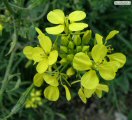 |
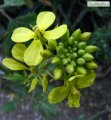 |
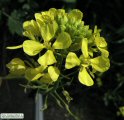 |
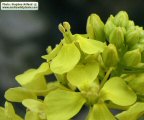 |
IMAGE: SNPAL-01 Close up photo of 3 flowers in the densely packed inflorescence with numerous green buds. |
IMAGE: SNPAL-02 Close up photo of a flower which consists of 4 spreading sepals, 4 cross shaped sulphur yellow flowers, 6 stamens and a central green pistil. |
IMAGE: SNPAL-03 Photo of flower inflorescence. Compared to other common, yellow-flowered cruciferae species in Malta, this species produces large number of buds and open-flowers per flowering stem. |
IMAGE: SNPAL-04 Close up photo of a flower in the cluster showing in detail the 4 long stamens and the central style with a swollen stigma. The other 2 lateral stamens are hidden in this photo. |
 |
 |
 |
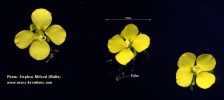 |
IMAGE: SNPAL-05 Photo of the inflorescence which is a raceme bearing 5-12 stalked flowers, and numerous buds at the apex. Petals of old flowers become more loose and spaced from each other. |
IMAGE: SNPAL-06 Photo of the flowering stem showing the densely packed inflorescences and the numerous and separated stacks of siliqua (fruiting pods). Each plant produces plenty of such flowering stems. |
IMAGE: SNPAL-07 Photo of the flowering stem (rachis). |
IMAGE: SNPAL-08 Scanned image of three flowers against a dark background. Stamens produce plenty of pale yellow pollen. |
 |
 |
 |
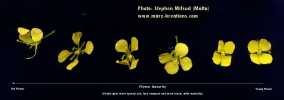 |
IMAGE: SNPAL-09 Annotated and scanned image of a longitudinal dissection of the flower. This clearly shows the arrangement of the 6 tetradynamous stamens, that is 2 lateral and short and 4 central and long, with the pistil in the center of the latter. |
IMAGE: SNPAL-10 Scanned image of the numerous buds found at the very tip of the raceme. The slender sepals of the calyx do not manage to cover completely the flower parts of the bud. |
IMAGE: SNPAL-11 Scanned image of buds and some flowers. |
IMAGE: SNPAL-12 Scanned image of several flowers at increasing maturity levels (right to left). Petals slightly overlap only in young flowers; Generally flowers do not have overlapping petals. |
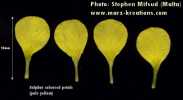 |
 |
 |
 |
IMAGE: SNPAL-13 Scanned image of the circular shaped petals, about 10mm in length. |
IMAGE: SNPAL-14 Scanned image of the long flowering stem with numerous fruit pods (siliqua) and a flowering cluster at the top. |
IMAGE: SNPAL-15 Photo of a young plant in situ. |
IMAGE: SNPAL-16 Photo of plant showing its several flowering stems. They have several spreading, white-looking fruit pods and topped with yellow inflorescences. |
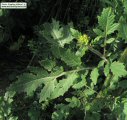 |
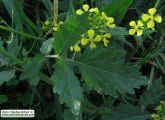 |
 |
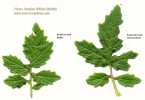 |
IMAGE: SNPAL-17 Photo of the leaves of the plant. They are lobed and have a serrated, non- spiny margin. |
IMAGE: SNPAL-18 Photo of a leaf blade in situ. |
IMAGE: SNPAL-19 Scanned image of various leaves of the plant. They are generally stalked, multi-lobed - with the largest leaf lobe being at the apex of the leaf, have a serrated outline and usually possess some white bristles. |
IMAGE: SNPAL-20 Magnified scanned image of two typical leaves. |
 |
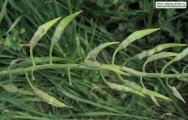 |
 |
 |
IMAGE: SNPAL-21 Photo of the flowering stems bearing its developing fruit pods. The pods have a coat of white bristles, particularly dense at the lower part of the fruit. As it can be seen in the unfocused photo (left), this makes the fruit appear white and hence the name of the plant - White Mustard. |
IMAGE: SNPAL-22 Close up photo of few siliqua (fruiting pods) in situ. |
IMAGE: SNPAL-23 Scanned image of 3 young fruit and their coat of white bristles. |
IMAGE: SNPAL-24 Annotated scanned image of 2 adult siliqua (fruit pods). They are bulging (with the seeds inside) and have a sabre-like long beak which does not bear any seeds. The fruit pods of this plant usually holds between 4-6 seeds. |
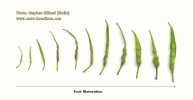 |
 |
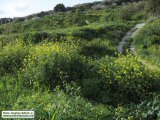 |
 |
IMAGE: SNPAL-25 Scanned image of several fruit increasing in maturity level from left to right. The white bristles are not much well contracted and observed against the white background. |
IMAGE: SNPAL-26 Photo of an uncropped field which seems obvious that was previously cultivated with this plant for harvesting purposes. It is assumed that this crop is harvested for the seeds to make mustard.Photo taken in fields near chadwik lakes (Feb 2005). |
IMAGE: SNPAL-27 Photo of numerous plants growing at the border of a field which was previously cultivated with white mustard. Plants have escaped and grown at the border of this and other neighbouring fields and also further away near this region. |
IMAGE: SNPAL-28 Photo of several plants in situ. Taken at Mtarfa - Mar 2005. |
 |
 |
 |
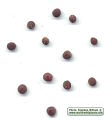 |
IMAGE: SNPAL-29 Close up image of stem showing its sparse white bristles. |
IMAGE: SNPAL-30 Colour illustration of the plant and its parts taken from Flora Danica Online. |
IMAGE: SNPAL-31 |
IMAGE: SNPAL-32 Scanned image of the globular seeds. |
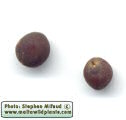 |
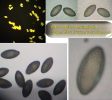 |
| | IMAGE: SNPAL-33 Magnified scanned image of brown seeds, approx 4mm across. |
IMAGE: SNPAL-34 Magnified image under light microscope of pollen. They have a rugby-ball shape, pitted surface and have 3 longitudinal grooves. |
IMAGE: SNPAL-35 |
IMAGE: SNPAL-36 |
|
| | |

